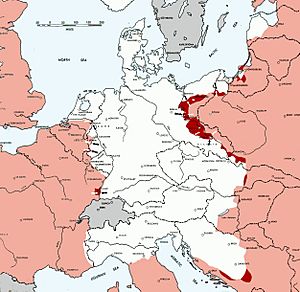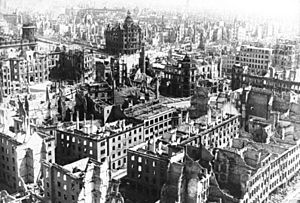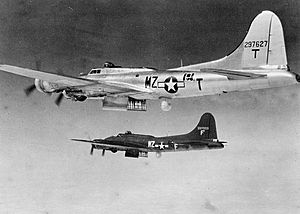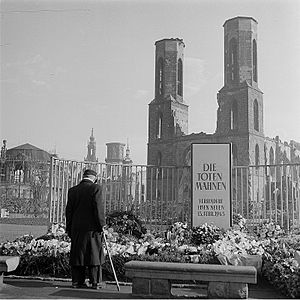Bombing of Dresden in World War II facts for kids
Quick facts for kids Bombing of Dresden |
|||||||
|---|---|---|---|---|---|---|---|
| Part of strategic bombing during World War II | |||||||
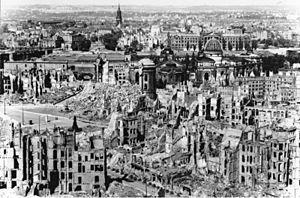 Dresden after the bombing |
|||||||
|
|||||||
| Belligerents | |||||||
| Strength | |||||||
|
|
||||||
| Casualties and losses | |||||||
| 7 aircraft (1 B-17 and 6 Lancasters, with crews) | Up to 25,000 people killed | ||||||
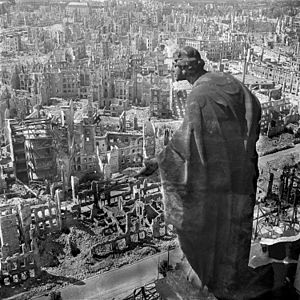
The bombing of Dresden was a series of air attacks on the city of Dresden, Germany, during World War II. Between February 13 and 15, 1945, British and American planes dropped over 3,900 tons of bombs. These bombs included both high-explosive bombs and incendiary devices (fire bombs). The attacks caused a huge firestorm that destroyed a large part of the city center. Up to 25,000 people were killed.
Later, there were more American air raids in March and April 1945. These targeted railway yards and industrial areas. After the war, people debated whether these attacks were necessary or right. Some called it a war crime. However, official reports from the US Air Force defended the bombing. They said Dresden was an important target for military transport and factories.
The number of deaths has been a big topic of discussion. Early claims by Nazi Germany were much higher than the real numbers. Today, historians agree that about 25,000 people died. This figure comes from studies, including one ordered by the city council in 2010.
Why Dresden Was Bombed
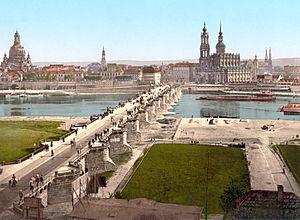
By early 1945, Germany was losing World War II. The German army was retreating on all fronts. The Soviet army was pushing into Germany from the east, getting close to Berlin.
Allied leaders, including British Prime Minister Winston Churchill, wanted to help the Soviet advance. They believed that bombing German cities in the east could cause confusion. This would make it harder for Germany to move troops and supplies. It would also make it difficult for people to escape from the east.
Dresden was chosen as a target for several reasons. It was Germany's seventh-largest city and had not been heavily bombed before. This meant it was still a working city. It was also a major hub for railways and communications. Many factories in Dresden supported the German war effort.
Dresden's Role in the War
Dresden was seen as an important industrial city. In 1944, the German Army listed 127 factories there that made war materials. The US Air Force said Dresden had 110 factories and 50,000 workers helping the war.
These factories made things like aircraft parts, anti-aircraft guns, and optical equipment. Dresden was also a key railway junction. It connected major cities like Berlin, Prague, Vienna, and Munich. This made it important for moving troops and supplies.
An RAF memo to pilots explained the reasons for the raid. It said Dresden was a large unbombed area. It was full of refugees and troops needing shelter. The memo also mentioned its importance as an industrial city. The goal was to hit Germany hard and show the Soviets what the British bombers could do.
The Air Attacks
The bombing of Dresden happened in several waves. The main attacks were on February 13-15, 1945.
Night of February 13/14
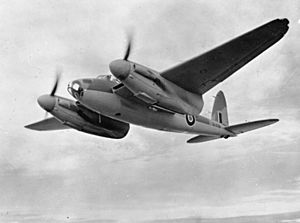
The first attack was by the British Royal Air Force (RAF). Bad weather stopped the American planes from flying that day. The RAF planned a "double strike." This meant a second wave of bombers would attack a few hours after the first. This was meant to hit rescue teams trying to put out fires.
- First Wave: Around 17:20 (5:20 PM) on February 13, British Lancaster bombers took off. Pathfinder planes dropped flares to light up Dresden. Then, Mosquito planes dropped target indicators (TIs) to mark the exact areas to bomb. The main target was the city's old town, with its crowded, wooden buildings.
- The main bomber force included 254 Lancasters. They carried 500 tons of high explosives and 375 tons of fire bombs. The high explosives were meant to break open buildings and create airflow. This would help the fires from the incendiary bombs spread faster.
- The first bombs fell at 22:13 (10:13 PM). The bombers dropped 881 tons of bombs.
- Second Wave: Three hours later, a second wave of 529 Lancasters arrived. By then, the fires from the first raid were huge. Smoke rose 15,000 feet high. The Pathfinders decided to expand the target area. They dropped flares on the main train station and a large park, which had not been hit before. Between 01:21 and 01:45 (1:21 AM and 1:45 AM), these bombers dropped over 1,800 tons of bombs.
February 14–15 Daytime Raids
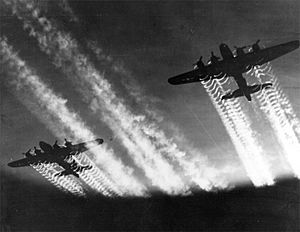
On the morning of February 14, American United States Army Air Force (USAAF) bombers took over.
- 316 B-17 Flying Fortresses bombed Dresden. They dropped 771 tons of bombs. About 40% of these were incendiary bombs, similar to the British "city-busting" mix.
- Some American planes missed Dresden due to clouds and bombed other cities like Prague.
- On February 15, more American bombers attacked Dresden. Their main target was a synthetic oil plant, but it was hidden by clouds. So, they bombed Dresden instead, using radar. These bombs were scattered over a wide area.
German Defenses and Casualties
Dresden's air defenses were weak. Many anti-aircraft guns had been moved to fight the Soviet army. Germany also had few pilots and little fuel for their planes.
Out of 796 British bombers, six were lost. Only one American bomber was shot down. This was because a large number of American fighter planes protected the bombers.
Impact on the Ground
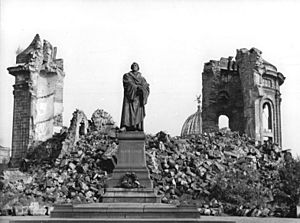
When the first bombs fell, Dresden's sirens sounded. Many people tried to find shelter in cellars. The city had removed thick cellar walls, replacing them with thin ones. This was so people could escape if one cellar collapsed. But with fires everywhere, people often ran from one burning cellar into another. Thousands died this way.
The bombing destroyed most of the city center. A police report said nearly 12,000 homes were destroyed. Many important buildings were also hit, including:
- Government buildings
- Railway lines
- Hospitals
- Shops and warehouses
- Schools and churches
- Factories
About 23% of Dresden's industrial buildings were badly damaged. 56% of other non-residential buildings were also severely damaged. Around 78,000 homes were completely destroyed.
Who Died?
The official German report from March 1945 said about 20,204 people had died. They expected the total to be around 25,000.
Many refugees were in Dresden at the time, fleeing from the Soviet army. Their exact numbers are unknown. The city did not count residents and refugees separately when figuring out the deaths.
In 2005, the Dresden city council asked historians to study the death toll again. Their 2010 report confirmed that between 22,700 and 25,000 people were killed.
After the Bombing
German Response
Nazi Germany used the bombing for propaganda. They claimed Dresden had no war industries and was only a city of culture. They also spread false numbers, saying 200,000 or even 500,000 people had died. This was done to make the Allies look bad.
This propaganda worked in some ways. It made people in neutral countries and even in Britain question the bombing.
British Response
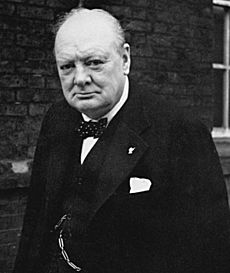
The destruction of Dresden caused concern in Britain. Some people, including Prime Minister Winston Churchill, started to rethink the bombing strategy. Churchill wrote a memo suggesting that bombing German cities "simply for the sake of increasing the terror" should be reviewed. He wanted to focus more on military targets.
Air Chief Marshal Arthur Harris, who led the RAF Bomber Command, disagreed. He believed bombing cities was justified if it shortened the war and saved Allied lives. He argued that Dresden was a military target. Churchill later withdrew his memo, but the debate continued.
American Response
The US Army Chief of Staff, General George C. Marshall, ordered an inquiry into the bombing. This inquiry said the raid was justified. It stated that Dresden was an important military target. It helped prevent German troops from moving and regrouping.
The inquiry also said that Dresden was not "undefended." It had anti-aircraft guns and military units nearby. The bombing methods used were similar to other raids on comparable targets. The report concluded that the bombing helped achieve military goals without too many civilian deaths.
Rebuilding Dresden



After the war, and especially after Germany was reunited, great efforts were made to rebuild Dresden. Many famous landmarks were restored.
- Coventry Partnership: In 1956, Dresden became a "twin town" with Coventry, England. Coventry had also been heavily bombed by Germany during the war. This partnership showed a spirit of reconciliation.
- Frauenkirche: The Church of Our Lady was a famous landmark. It collapsed after the bombing, and its ruins were left as a memorial. After the fall of the Berlin Wall, people started an international effort to rebuild it. A British charity, the Dresden Trust, helped raise money. The new Frauenkirche was finished in 2005. Its new cross was made in London, partly from old nails from Coventry Cathedral, which was also destroyed in the war.
- Neumarkt: The Dresden Historical Neumarkt Society (GHND) was formed in 1999. They wanted to rebuild the historic city center around the Frauenkirche. Many old baroque buildings have been reconstructed, mixing old designs with new ones.
Debate and Legacy
The bombing of Dresden remains a topic of strong debate. People still discuss whether it was morally right and militarily necessary.
Some historians see it as a tragic event. Dresden was a beautiful city, a symbol of German culture. But it also had ties to the Nazi regime. The debate often focuses on:
- The Nazi government's false claims about the death toll.
- The beauty of the city and its cultural importance.
- The deliberate creation of a firestorm.
- The number of people killed.
- Whether it was a necessary military target, especially so late in the war.
The Hague Conventions set rules for warfare. But they were written before air power became common. So, whether the bombing was a war crime depends on how these older laws are interpreted.
Some argue that Dresden was a military target. They point to its factories and railway lines. Others argue that the main industrial areas were outside the city center and were not targeted. They believe the bombing was mainly aimed at destroying the city itself.
The bombing of Dresden is a powerful reminder of the horrors of 20th-century warfare. It shows how war can lead to immense destruction and loss of life.
Timeline
| Date | Target area | Force | Aircraft | High explosive bombs on target (tons) |
Incendiary bombs on target (tons) |
Total tonnage |
|---|---|---|---|---|---|---|
| 7 October 1944 | Marshalling yards | US 8th AF | 30 | 72.5 | — | 72.5 |
| 16 January 1945 | Marshalling yards | US 8th AF | 133 | 279.8 | 41.6 | 321.4 |
| 13/14 February 1945 | City area | RAF BC | 772 | 1477.7 | 1181.6 | 2659.3 |
| 14 February 1945 | Marshalling yards | US 8th AF | 316 | 487.7 | 294.3 | 782.0 |
| 15 February 1945 | Marshalling yards | US 8th AF | 211 | 465.6 | — | 465.6 |
| 2 March 1945 | Marshalling yards | US 8th AF | 406 | 940.3 | 140.5 | 1080.8 |
| 17 April 1945 | Marshalling yards | US 8th AF | 572 | 1526.4 | 164.5 | 1690.9 |
| 17 April 1945 | Industrial area | US 8th AF | 8 | 28.0 | — | 28.0 |
Images for kids
-
Lancaster releases a 4,000 lb (1,800 kg) HC "cookie" and 108 30 lb (14 kg) "J" incendiaries. (over Duisburg 1944)
-
A memorial at Heidefriedhof cemetery in Dresden. It reads: "Wieviele starben? Wer kennt die Zahl? An deinen Wunden sieht man die Qual der Namenlosen, die hier verbrannt, im Höllenfeuer aus Menschenhand." ("How many died? Who knows the count? In your wounds one sees the agony of the nameless, who in here were conflagrated, in the hellfire made by hands of man.")



